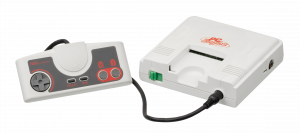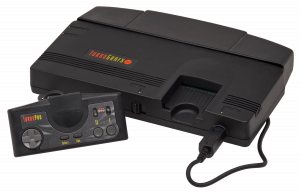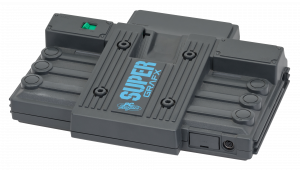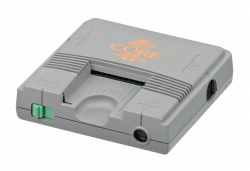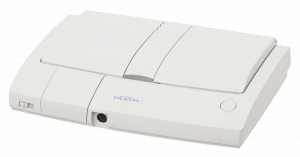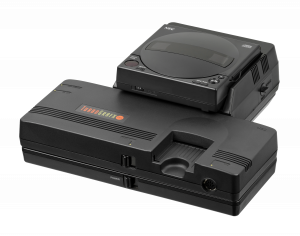TurboGrafx-16 Model Differences
Some page content & researching collaboratively taken from io55.net's TurboGrafx-16 page with permission.
There are twelve TG-16/PCE models.
Models
Models are arranged chronologically. There are no revisions.
PC Engine (1987-1989)
The original version of the PC Engine/TurboGrafx-16 hardware, released on October 30, 1987 in Japan. It is a small, white-colored console dominated by the HuCard slot on the top front. Each side of the console has a different connection, with the single mini-DIN controller port at the front, power input on the left, RF out on the right and a large expansion port on the rear.
TurboGrafx-16 (1989-1991)
The original USA version of the PC Engine, branded as the TurboGrafx-16 and released in 1989. This is the vastly more common version of the TurboGrafx-16 hardware in the USA. Like its Japanese counterpart, it requires certain add-ons (i.e. TurboTap for multiple players, TurboBooster Plus for AV output and saving) to fully experience certain games. It is recognizable by its obvious lack of a CD drive, plus a large HuCard/TurboChip recess on the top right. The console has a large expansion port on the back that is largely identical to the Japanese PC Engine expansion port (the pinout is identical but the shape is slightly different). It only has RF out and one controller port, much like the original PC Engine. For the controller port, NEC used a full-size DIN connector for the TurboGrafx as opposed to the mini-DIN used on the PC Engine. It is also about double the length of a PC Engine; this was done in order for the console to meet FCC requirements, as the console has extensive RF shielding and a redesigned main board which isolates much of the digital circuitry from the analog side.
The TurboGrafx-16 is not compatible with PC Engine HuCards and vice versa. Several third-party adapters have been made over the years to allow for the use of PC Engine HuCards on US hardware, as the PC Engine had a much larger library due to its relatively high popularity in Japan. In more recent years, PC Engine games have been considerably less expensive than their US counterparts in the used game market, making such adapters a more attractive proposition.
PC Engine Shuttle (1989)
Perhaps one of the oddest PC Engine consoles to exist, the PC Engine Shuttle was released on November 22, 1989 as a cost-reduced version of the PC Engine. It is unusual in that the console is designed like a toy spaceship, presumably to appeal to a younger audience. The Shuttle was also bundled with a more ergonomic version of the standard Turbo Pad and was the first PC Engine console to feature AV out instead of RF, using the same 5-pin DIN connector as all later consoles. Because the Shuttle has a truncated expansion port and due to its odd shape, it is not compatible with the PC Engine CD or any other accessories which make use of the expansion port. NEC did release a memory backup unit for the Shuttle but nothing more.
PC Engine SuperGrafx (1989-1990)
In response to the Sega Mega Drive and the upcoming Super Famicom, NEC and Hudson Soft designed an upgraded variant of the PC Engine, known as the PC Engine SuperGrafx and released on December 8, 1989. Internally, the SuperGrafx features an additional HuC6270 video display controller, allowing for more complex background scrolling and more sprites. The console has a rather odd design which resembles a car engine, even including fake bolts on the top. HuCards load on the top rear and face the opposite way compared to all other PC Engine consoles, although SuperGrafx-specific games have their labels facing the other way to compensate. The AV out is located on the right-hand side with the power input on the left towards the rear. The back of the console features the same expansion port as the regular PC Engine and is compatible with most of the same accessories.
At the front right is the single controller port as well as a covered 18-pin connector not seen on any other PC Engine console. This connector was intended for an utterly massive analog joystick attachment known as the "Power Console", which plugged into this port and sat atop the SuperGrafx. However, it never went beyond the prototype phase and was unreleased. The SuperGrafx also has a compatibility switch as two standard games (Momotarou Dentetsu and Space Harrier) will not boot with the additional HuC6270 present.
Because of the console's large size, the SuperGrafx will not fit in a PC Engine CD IFU-30 interface. To solve this issue, NEC released an adapter known as the RAU-30, which had a PC Engine-shaped attachment at one end that plugged into the interface. The later Super CD-ROM2 will fit onto a SuperGrafx without an adapter, though such a setup will require two AC adapters unless one makes a suitable jumper cable (as the one included with the Super CD-ROM2 will only work with a standard PC Engine).
Only seven games were released for the SuperGrafx and of these, two are also compatible with a standard PC Engine (Darius Alpha and Darius Plus). The SuperGrafx was ultimately a massive flop for NEC and it was quietly discontinued during 1990, with the last game, 1941: Counter Attack, being released in August 1991.
PC Engine Core Grafx (1989-1991)
Released alongside the SuperGrafx on December 8, 1989, the Core Grafx was the first major revision to the original PC Engine design in Japan. It eschews the original white and red color scheme for a dark gray and blue one, made to match the SuperGrafx and the recently released Shuttle. There are no major internal differences save for the addition of a 5-pin DIN connector for stereo AV out, replacing the original console's RF modulator. The Core Grafx also has a revised CPU, the HuC6280A, which supposedly corrects some audio distortion issues (need evidence for this!). It is still 100% compatible with all PC Engine accessories including the PC Engine CD.
PC Engine GT/TurboExpress (1990-1991)
Perhaps inspired by the success of Nintendo's Game Boy, NEC released a portable version of the PC Engine known as the PC Engine GT on December 1, 1990, and released around the same time in the US as the TurboExpress. It is the first example of a handheld game system which plays the same games as a home console, predating the Sega Genesis Nomad by five years. The GT/TurboExpress is a very bulky system by modern standards (around 1.8 inches thick!) and takes six AA batteries, which are depleted in only 2-3 hours due to its fluorescent backlit color screen. The system also features a port on the side for an optional TV tuner so it can also double as a portable color TV.
Service Note
All PC Engine GT and TurboExpress systems suffer from bad electrolytic capacitors, which will leak and cause damage to both the motherboard and daughterboard for the controls. Any system not previously serviced must have its capacitors replaced, which should also include a thorough cleaning of the internals to remove any leaked electrolytic fluid and repair to any corroded areas of the internals.
PAL TurboGrafx (1990)
In 1990, NEC planned an official release of the TurboGrafx-16 in Europe and designed a slightly altered version of the console known simply as the TurboGrafx. This console very closely resembles its US counterpart, but is molded in a light gray case (as opposed to the US's black) and features a unique logo with red and blue stripes under the "TurboGrafx" text. Unlike the US console, the European TurboGrafx has stereo AV out via a 5-pin DIN connector in place of an RF modulator (though this connector has differently spaced pins compared to a standard 5-pin DIN). Being a European console, the TurboGrafx outputs 50 Hz PAL video. The TurboGrafx will also interface with a TurboGrafx-CD, but because the console runs at 50 Hz, the audio for cutscenes in CD games will not be synced to the video. It is also not compatible with PC Engine games like its US counterpart.
It is unknown if the TurboGrafx actually received a release as most PAL TurboGrafx consoles have been new old stock (NOS) units and there were no PAL-specific games ever released. The console was packed in with either Blazing Lazers or Victory Run, which are unaltered US copies.
PC Engine Core Grafx II (1991-1992)
The Core Grafx II is a revised version of the original Core Grafx, released on June 21, 1991 for a reduced price. It is mostly a cosmetic revision with a new light gray case, although NEC reverted to using the original HuC6280 CPU for some unknown reason.
PC Engine LT (1991-1992)
The rarest and perhaps most extravagant PC Engine console ever released, the PC Engine LT (the LT standing for LapTop) is a semi-portable system featuring a built-in 4" LCD display and made to resemble a small laptop. It also features a built-in TV tuner so it can be used as a small desktop TV set. Despite the built-in screen, it is not a true portable and must be connected to an AC adapter to function. However, it is still a fully functional PC Engine console and can even interface with a PC Engine CD or Super CD-ROM2 add-on (the latter requires the PI-AD18 extension piece). Due to its eye-watering retail price of 99,800 yen, few were sold and they have since become expensive collector's items.
Service Note
Much like the GT, the PC Engine LT also suffers from bad electrolytic capacitors. All untouched systems must be serviced in the same manner in order to keep them functioning.
PC Engine Duo/TurboDuo (1991-1993)
On September 21, 1991, NEC released the first combination PC Engine/PC Engine CD console, the PC Engine Duo. It is the first PC Engine to feature compatibility with the new Super CD-ROM2 standard, which adds additional cache RAM (256 KB from 64 KB previously) to allow for more complex CD-based games on the platform and reduce load times. The Duo features a sleek, attractive design (which earned NEC a Good Design Award for 1991 from the Japan Institute of Design Promotion) with a green power switch on the left hand side, a HuCard slot concealed behind a flip-top door, and a top-loading CD tray on the top right with a purple eject button and door lock switch. On the left-hand edge is the 5-pin DIN connector for AV out and a stereo headphone jack with volume control. NEC also marketed several novel accessories for the Duo in Japan, including a battery pack and a small LCD monitor. Unlike standalone PC Engine consoles, the Duo does not feature an expansion port.
In October 1992, the Duo made its way stateside as the TurboDuo and was released by Turbo Technologies Incorporated (TTI), a joint venture between Hudson Soft and NEC. It is largely identical to its Japanese counterpart except that it is only compatible with TurboGrafx-16 HuCards/TurboChips and features an all-black design. Because the TurboDuo was the first US console to feature the same mini-DIN controller port as the PC Engine, TTI also released an optional adapter to allow users to connect a TG-16 TurboPad or TurboTap to the console. Unfortunately, the TurboDuo was released during a time when the TurboGrafx-16's already small market presence was disappearing and few were sold, with the system being discontinued about a year later. This made it the final iteration of the PC Engine/TurboGrafx-16 hardware released outside Japan.
Service Note
All Duo consoles which have not been previously serviced suffer from leaky capacitors, which can cause motherboard damage if not caught in time. Due to the Duo's more complex design, a thorough cleaning of the board and inspection for potential damage caused by leaked fluid are absolutely paramount. Due to this reason, it is not uncommon for Duos to require some level of board repair during a recap.
PC Engine Duo-R (1993-1994)
Released on March 25, 1993 in Japan only, the PC Engine Duo-R is a cost-reduced revision of the original Duo. It is largely identical in functionality, but loses the headphone jack and door lock switch from the original. The Duo-R features a rounded (hence the "R") case molded in an off-white color with the AV out relocated to the rear of the console. Like its predecessor, the Duo-R also won a Good Design Award.
Two board revisions of the Duo-R exist, the PWA-3339-A and PWA-3365-A. The former has a replaceable glass fuse as part of the power circuit and has slightly more electrolytic capacitors near the HuCard slot, while the latter has no fuse and less capacitors. In terms of reliability, the Duo-R is far more dependable than the original Duo and does not suffer from having leaky surface mount capacitors.
PC Engine Duo-RX (1994-1995)
On June 25, 1994, NEC released the final iteration of the PC Engine hardware, the PC Engine Duo-RX. It is almost totally identical to the Duo-R, but has a slight blue-gray tinge to the case and has a purple eject button. The console was also packaged with a 6-button controller similar to the one later introduced with the PC-FX, and retailed for a cheaper price than the Duo-R (29,800 yen vs. 39,800 yen). Internally the Duo-RX is identical to later revisions of the Duo-R, using the same PWA-3365-A motherboard revision.
CD Add-Ons
There are three TG-16/PCE CD addon models.
Models are arranged chronologically. There are no major revisions.
PC Engine CD (1988-1991)
The first add-on that allowed a game console to play games on optical media, the PC Engine CD was released on December 4, 1988. In addition to playing games from CDs, the PC Engine CD also expanded the PC Engine's capabilities by adding an Oki ADPCM sound chip for digitized sample playback, and the ability to save games via a supercapacitor-backed SRAM chip. The add-on also has 64 KB of RAM used as cache RAM for CD games.
A PC Engine CD setup consists of two parts, the IFU-30 interface and CDR-30 CD player, which were initially sold separately for tax reasons but later sold together. Resembling a small briefcase (hence its nickname), the IFU-30 connects both the PC Engine and CDR-30 together, with the CDR-30 on the left-hand side and PC Engine console on the right. It features its own power switch which connects power to both components and also provides AV out via RCA jacks, allowing for easy connection to a TV with composite inputs or a stereo system. This is especially useful for the original PC Engine which only has RF out. The IFU-30 is powered via a single AC adapter, avoiding cable clutter. A large lever is on the rear center of the interface which ejects both components.
In addition to connecting to the IFU-30, the CDR-30 can also function as a standalone CD player for playing music, and even features a headphone jack with volume control and a line-level output for connection to a stereo system. However, it is not portable as it must be connected to an AC adapter and does not have skip protection like most portable CD players.
Also bundled with the PC Engine CD was a system card which acts as the system's BIOS. The system was initially bundled with the Ver. 1.0 card, though 2.0 and 2.1 cards were later released. NEC released a Ver. 3.0 card in 1991 with the introduction of the Super CD-ROM2 standard, and an Arcade Card Pro in 1994. Both cards also provide additional RAM, with the 3.0 card expanding the total combined RAM to 256 KB and the Arcade Card Pro to 2 MB.
When NEC began bundling the components together in 1989, NEC released slight revisions to them known as the IFU-30A and CDR-30A. These are largely identical except for additional ground points on both components and a "CD-ROM2 System" logo on the interface's lid in place of the "IFU-30" text. They are also mostly identical internally, although the IFU-30A uses SMD chips for the 64 KB cache RAM as opposed to the array of DIP chips used in the original IFU-30.
Service Note
The center gear in the CDR-30's drive mechanism has been known to swell and disintegrate due to age, which will cause the drive to stop reading discs as the laser is unable to move across the sled. Gear replacements can be found through various sources and is a fairly easy repair to accomplish, which usually restores the drive to fully working order.
Most CDR-30s are also susceptible to leaky capacitors (especially near the audio section), therefore it is recommended that all CDR-30s receive a full recapping in addition to having the center gear replaced.
TurboGrafx-CD (1989-1991)
When NEC brought over the PC Engine stateside as the TurboGrafx-16, they also decided to bring over the CD add-on as the TurboGrafx-CD, released soon after the TG-16 towards the end of 1989. Due to the TG-16's larger shape compared to the PC Engine, the interface unit was drastically redesigned to a less aesthetically-pleasing arrangement, placing the CD drive behind and above the console instead of by its side. The AV out and power input were also moved to the rear of the interface, and two locking dials were added, one to the bottom which locks the TG-16 to the dock and another which locks the CD drive in place; these both prevent the combination from powering on if left unlocked, so as to prevent damage to any of the components if a connection is broken. Although largely identical to its Japanese counterpart, the CD drive is colored black to match the rest of the setup and has a different door design. Both units are fully interchangeable, so it is possible to use a Japanese drive on a TG-CD and vice versa. The setup was also bundled with the Ver. 2.0 card. Note that Japanese system cards will not work on a TurboGrafx-16 and vice versa just like with HuCard games. However, CD games are not region-locked.
Due to its initial high retail price of US$399 ($200 more than the TG-16 itself), the TurboGrafx-CD did not catch on and sold relatively poorly.
Service Note
Because the TurboGrafx-CD uses the same CD drive as the PC Engine CD, the same issues as detailed above apply.
Super CD-ROM2 (1991-1992)
Released on December 13, 1991, the Super CD-ROM2 is a redesigned expansion which combines the interface and CD drive with a Ver 3.0 system card into a single unit for full Super CD-ROM2 functionality. This essentially makes an attached console functionally identical to a Duo console. It is a long unit, molded in light gray plastic which matches the Core Grafx II and LT. It attaches directly behind the PC Engine and uses a small jumper cable to allow the entire setup to be powered via a single AC adapter, though this jumper cable will only fit standard PC Engine consoles. AV out is provided via the same 5-pin DIN connector found on most standalone consoles, located on the right-hand side. Interestingly, the Super CD-ROM2 has a unique additional expansion port located behind a cover on the bottom of the unit, though NEC never released any accessories for it.
This was the last CD expansion released for the PC Engine as NEC would focus on the Duo consoles from this point forward.
Note that the Super CD-ROM2 will not fit on a TurboGrafx-16 due to the differently shaped expansion port (though the pinout is identical).
Service Note
Although not as bad as the Duo, the Super CD-ROM2 has been known to have issues with leaky capacitors.
References
https://en.wikipedia.org/wiki/TurboDuo
https://en.wikipedia.org/wiki/TurboGrafx-16
https://www.racketboy.com/retro/tubrografix-16-tg16-101-beginners-guide
